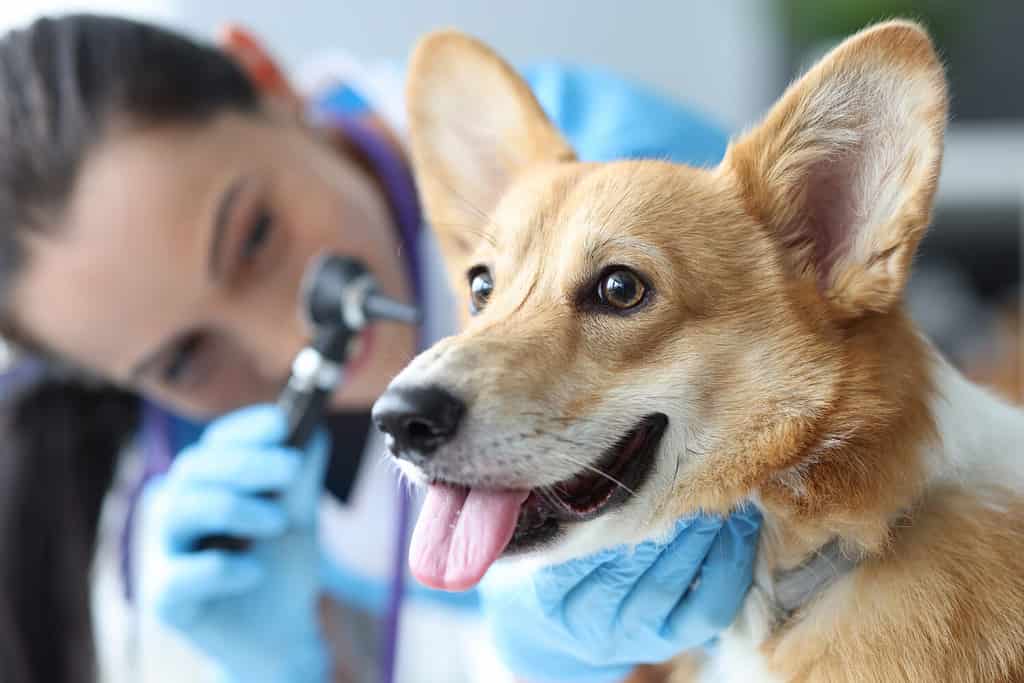To own a dog is to know a special kind of love. To care for a special needs dog is to learn how to love unconditionally. Those who adopt special needs pups bond with their pups in a unique way as they navigate the challenges they both face. Even though they may have struggles other dogs don’t have, they can still live a magical life with the right owner. Discover six types of special needs dogs!
1. Deaf Dogs

With some accommodation, deaf dogs enjoy a long, healthy life.
©megaflopp/Shutterstock.com
Deafness in dogs is not the kind of condition you can see at first glance, but it does affect how your dog walks through the world and how you interact with them. Hearing loss may be the result of trauma, or it could be a genetic defect. But in many cases, a dog loses its hearing gradually.
A deaf dog isn’t going to respond to commands or pick up on familiar sounds in the home like the rattle of your keys. However, a deaf dog is still going to look to you for guidance, which means you can use your body language to train them.
You might even consider working with a professional trainer or adopting a companion dog so that your deaf dog can take cues from your hearing dog. Most importantly, you must keep your deaf dog safe. They don’t know when a car is coming so they should be on a leash and close to you during walks. With proper care, a deaf dog can live a long and fabulous life.
2. Dogs With PTSD

Pups with dark pasts need extra support as they learn to feel safe again.
©Patrick H/Shutterstock.com
Could it be possible? PTSD in animals? Yes, a dog that has been abused or has suffered through a traumatic event may have special needs for you to consider. For instance, dogs are often afraid of loud sounds, especially during big celebrations that include fireworks. Just like these loud sounds can trigger a dog without PTSD, a dog that has endured traumatic events may also have an array of triggers that send them into a spin.
Since your dog can’t articulate exactly what it is that hurt them, it’s your job to figure out what those triggers are and keep your dog from re-experiencing that same terror or fear. These dogs need a lot of patience and a lot of love to feel secure again.
3. Blind Dogs

Dogs may be born blind but in many cases, this occurs gradually as they get older.
©Lutsiv Maxim/Shutterstock.com
Blindness in dogs may occur for a range of reasons. For many dogs, blindness occurs as a result of old age. But just because a dog that previously had vision is no longer able to see, it doesn’t mean that they can’t still live a full life. However, the onus is on you to make sure that their life is enriched as they adjust to vision loss.
According to the American Kennel Club, you should mind safety first. You need to keep up with routines so that your dog knows what to expect and isn’t guessing your next move. Keep your furniture arranged in the same way so your dog doesn’t have any accidents. In a new environment, your dog is going to need you to help them map out the area. You’ll need to block off stairs and maybe even get a dog bumper to help keep them safe from bumping into things. Over time, blind dogs get accustomed to being unable to see and adjust to their new routines.
4. Physically Disabled Dogs

Physical disabilities manifest in different ways and some dogs may need more help than others.
©Hryshchyshen Serhii/Shutterstock.com
Dogs with missing limbs or partial paralysis need extra care from their owners. Before adopting a dog with a physical disability, you must plan to make sure that you can care for their special needs. A dog with a physical disability may need a wheelchair, medication, or even physical therapy. A dog with paralysis won’t be able to entertain itself so they may experience boredom more frequently. This is why it’s crucial that you are present for a physically disabled dog, tending to their needs and ensuring they are sufficiently stimulated, both mentally and physically.
5. Dogs With Neurological Issues

There are some common neurological conditions dogs suffer from, including seizures.
©Javier Brosch/Shutterstock.com
There are several different neurological disorders that a dog may be dealing with. Some of the most common include seizures, wobbler syndrome, and cognitive dysfunction. With each of these conditions, you have different responsibilities. For example, a dog that experiences seizures will likely be prescribed medication for life. Not only is this an expense you have to budget for, but it’s also something you have to administer regularly. So long as you understand the condition, you actively work with a vet, and you know how to properly care for a dog with a neurological condition, these pups can experience love and life alongside you.
6. Terminally Ill Dogs

A dog with a terminal illness may not have much time, but their love is unending.
©Olya Maximenko/Shutterstock.com
Most turn away from the sadness that inevitably overwhelms them in these cases. It’s the type of thing you don’t want to think about. But because this is the common perspective, many terminally ill dogs end up in shelters, living out their last days in an environment that doesn’t support their best life. Adopting a terminally ill dog is going to break your heart but it’s also going to fill all of those cracks with the kind of unconditional love only a dog can give.
Erika Roldan, a long-time dog-lover who lives in CA understands this plight and has rescued two terminally ill dogs. She told A-Z-Animals, “It’s not easy. You have to have the heart for the job. I would do it all over again though.”
Depending on the type of illness, you may have to administer medication or help with hygiene. But ultimately, no matter how much time you have with a dog like this, it’s always worth it. Their gratitude for your care will resonate in your home without end.
The photo featured at the top of this post is © selvaco/Shutterstock.com
Ready to discover the top 10 cutest dog breeds in the entire world?
How about the fastest dogs, the largest dogs and those that are -- quite frankly -- just the kindest dogs on the planet? Each day, AZ Animals sends out lists just like this to our thousands of email subscribers. And the best part? It's FREE. Join today by entering your email below.
Thank you for reading! Have some feedback for us? Contact the AZ Animals editorial team.






